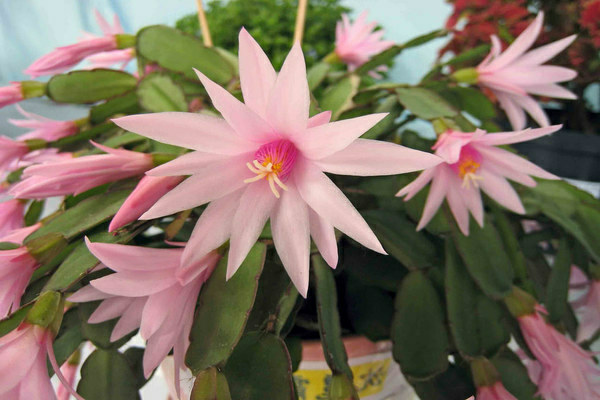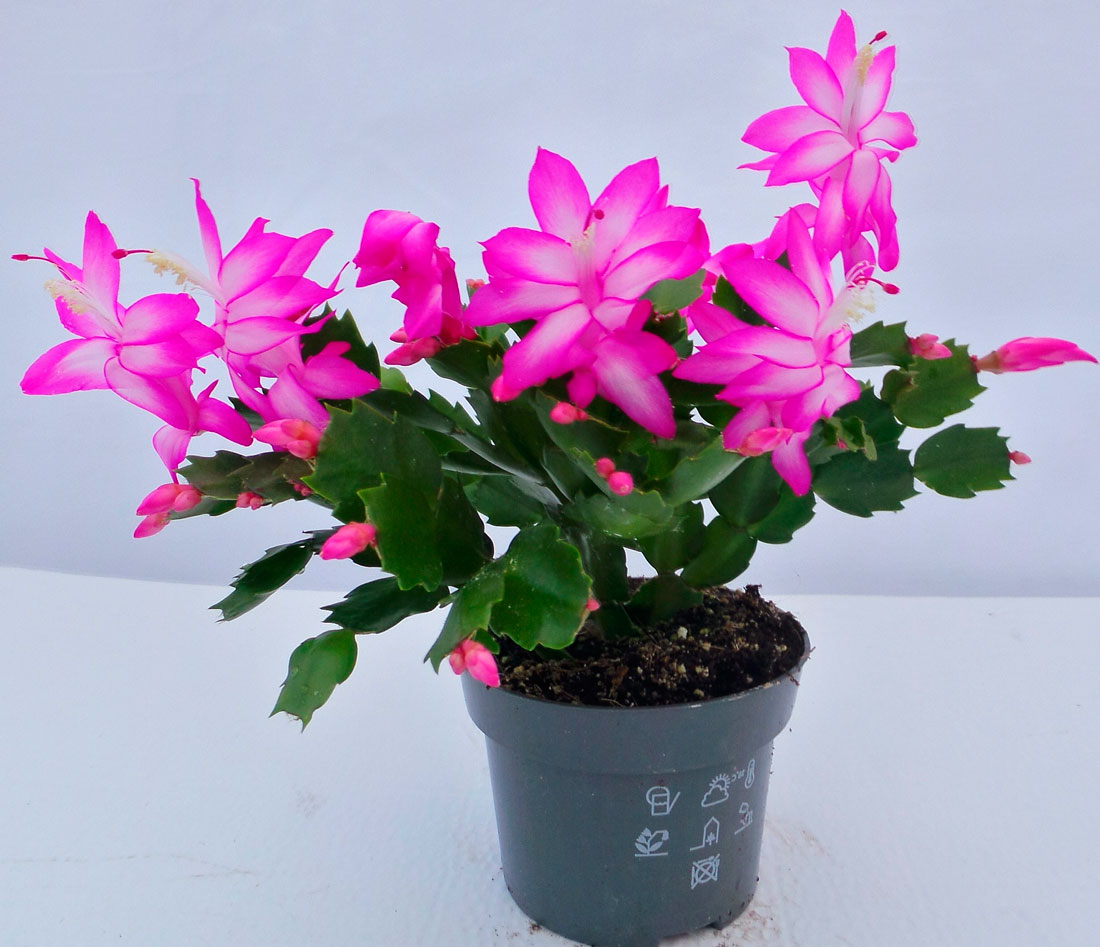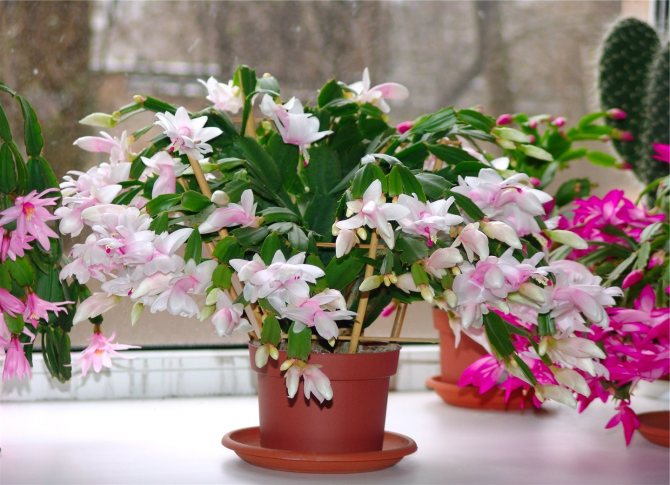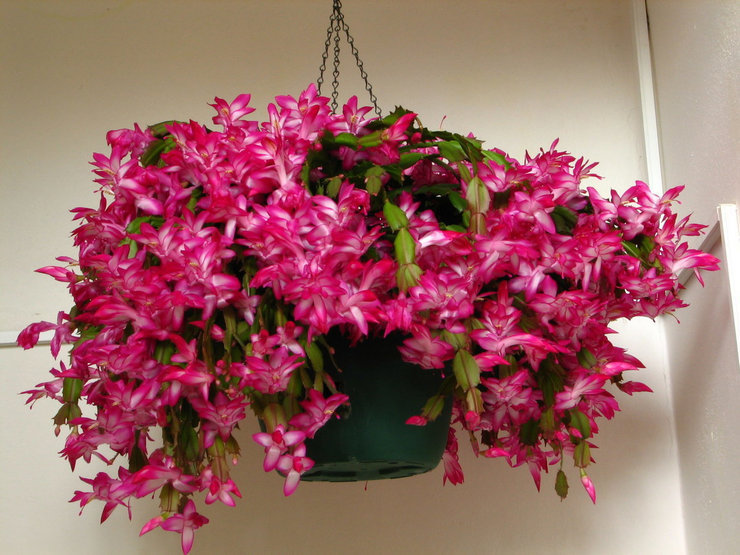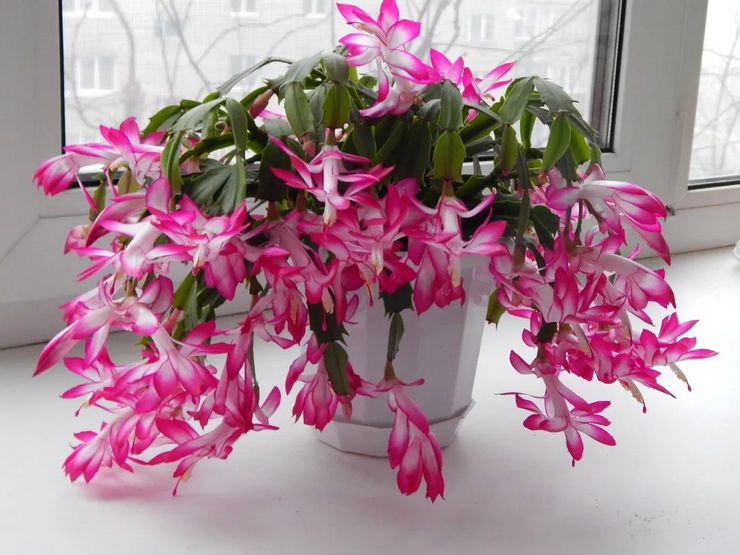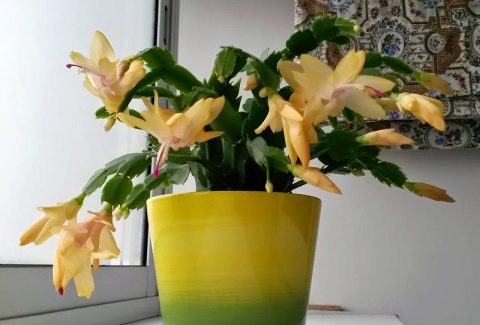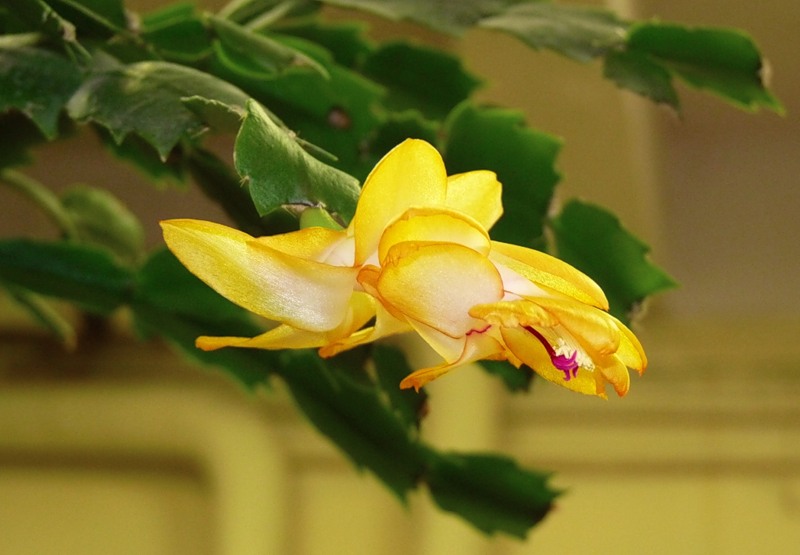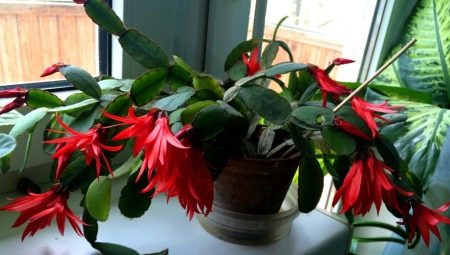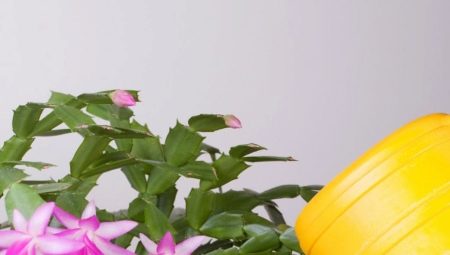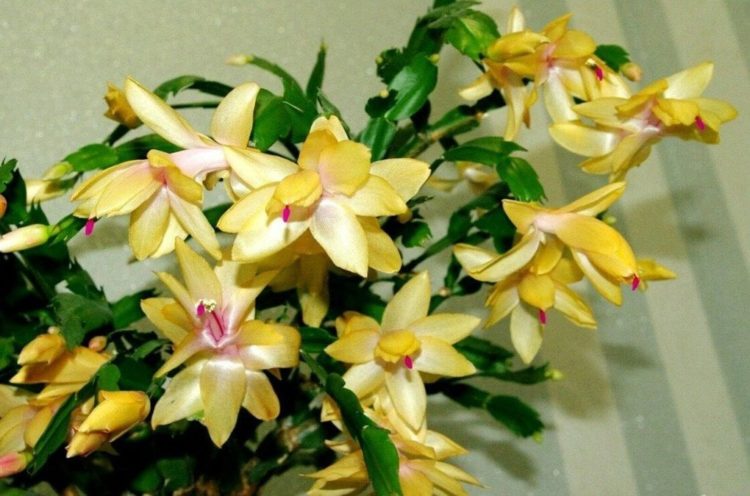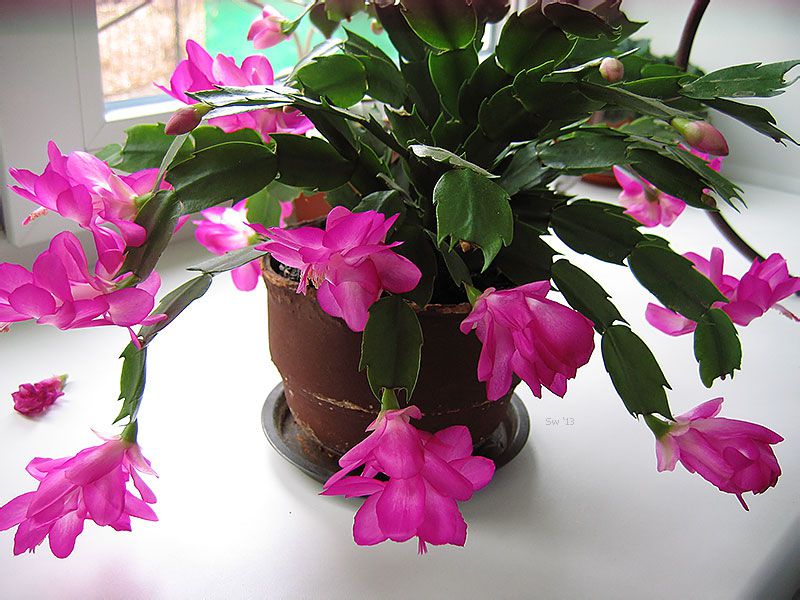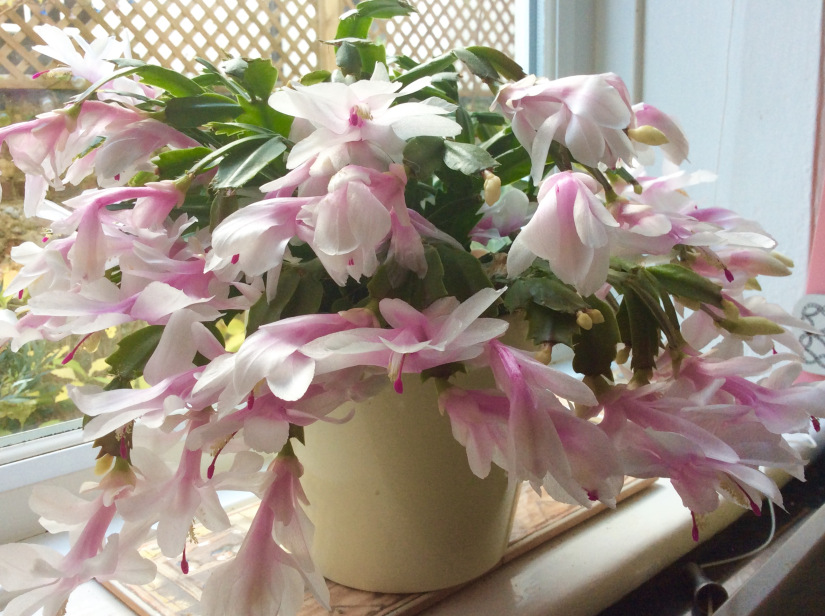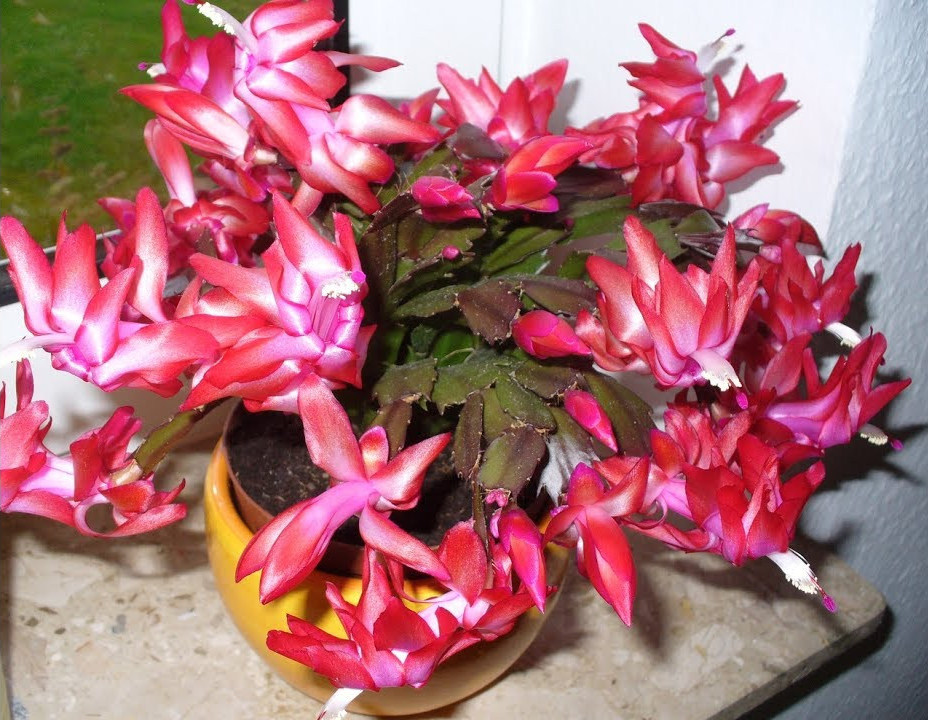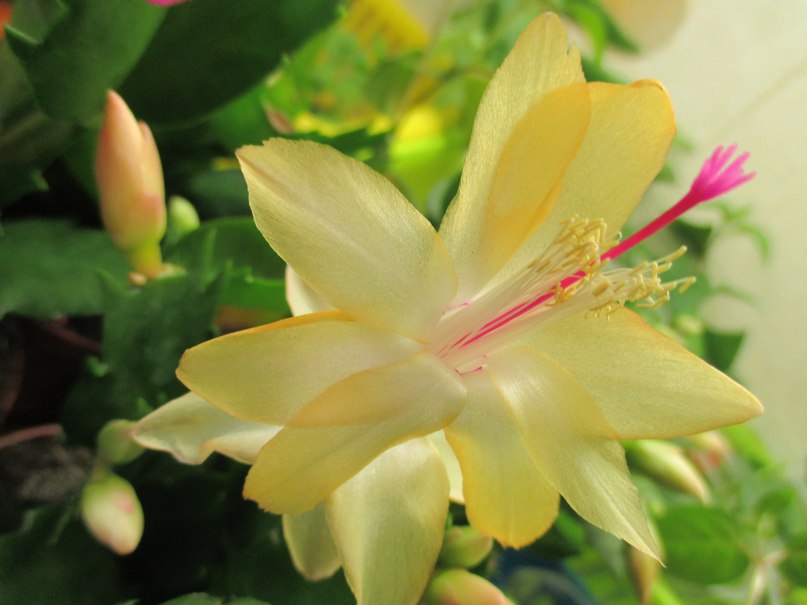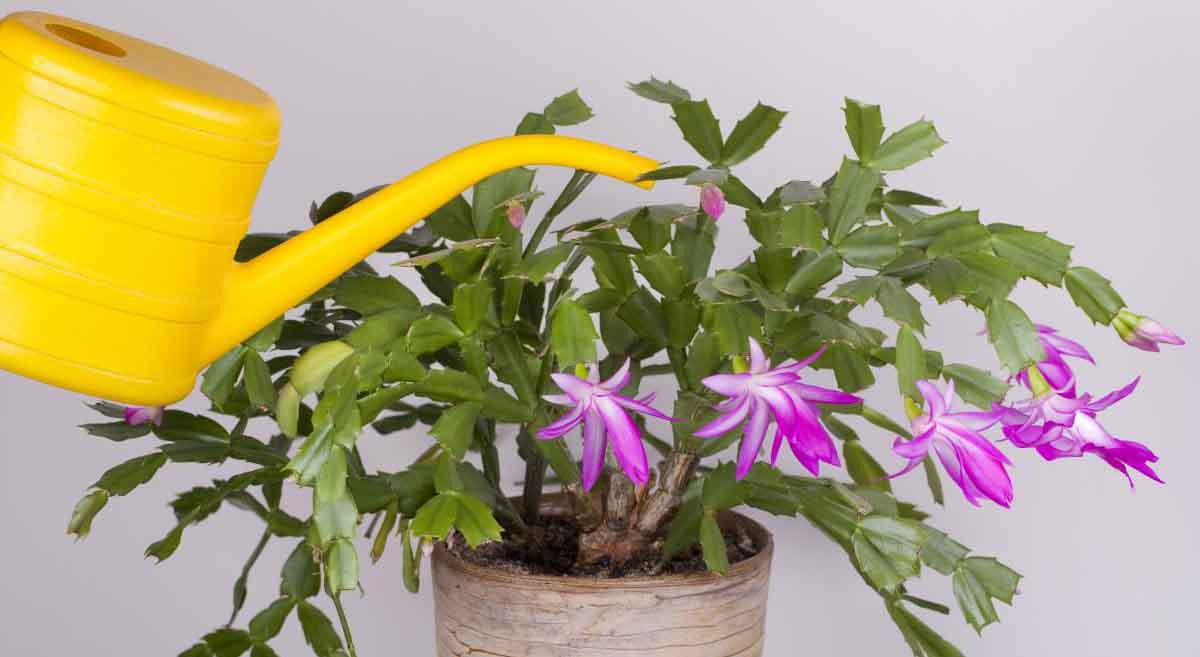Reproduction
Cuttings
The easiest way to propagate a Schlumberger vegetatively is with the help of stem cuttings, consisting of a couple of three segments. They do this after the formation of the crown, when there are a lot of cuttings of shoots, or from April to May in the phase of active vegetation of plants.
Cuttings are separated from the mother flower, dried for 2 days and rooted in water or in moist soil under a greenhouse.

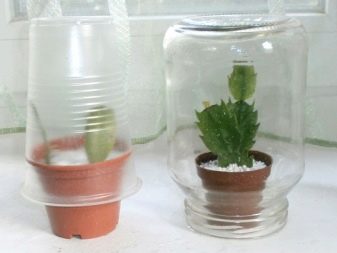
Seeds
New hybrid Schlumberger varieties are grown from seed. Getting your own seeds is troublesome, as the plants need pollination, so purchased seeds are usually used. The optimal time for sowing is from May to June. Pre-sowing treatment of seed implies its warming up at t 50-60 ° C and soaking in a biostimulant solution. Next, the seeds are placed in a container with wet sand or a soil mixture of sand and earth, without deep embedding, under a greenhouse. Inside, they maintain a temperature of 23-25 ° C, water the seedlings and arrange for them to be regularly ventilated. It takes from 3 weeks to a month to wait for the appearance of the first shoots. After 1.5-2 months from the moment the shoots appeared, the plants dive. Flowering can be expected only 2-3 years after sowing.


Vaccination
To get the standard form of the Decembrist, it is grafted onto other cacti such as prickly pear, cereus, pereskii. To do this, cut off the upper part of the cactus rootstock, place the Decembrist rootstock in the split in the form of a cutting of three fragments and fix it with a toothpick or cactus thorns, and then wrap it with a cloth or thread. It takes from a crescent to 3 weeks for the scion to grow together with the stock. After that, the bandage is removed and the standard zygocactus is tied to one or two supports for the trunk and crown so that it does not break at the vaccination site due to its weight. Compared to ordinary Decembrists, the plants on the stem have much more lush flowering.
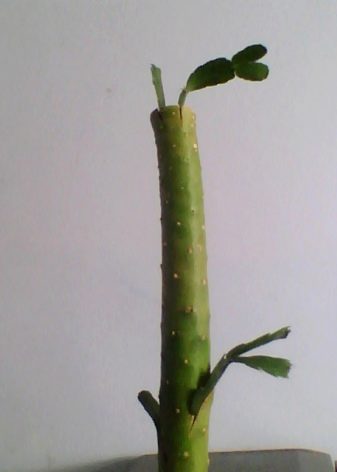

How to care at home
Zygocactus, like many other indoor flowers, has its own signs and superstitions. Therefore, before bringing a flower into the house, it is advisable to find out about the nature of the green pet.
The benefit of the Decembrist is that it is a plant-indicator of the atmosphere in the house. If it grows and blooms on time, the family is in order. If it bloomed ahead of schedule, the year will be rich in pleasant events.
Flower harm can bring too superstitious people who will worry about problems with flowering or the condition of the flower.
It is not difficult to decide whether it is possible to keep a Decembrist at home if you already have the skills to grow indoor flowers. Despite the fact that the Decembrist belongs to the cactus family, he has good energy.
The Decembrist is considered not capricious, but he needs the right care for good health and beautiful flowering. Since the plant is native to the tropics, in at home to him it is necessary to create a similar microclimate.
Some are worried about the moment: is zygocactus poisonous or not? The Decembrist is one of the non-poisonous plants, and the toxic properties are not indicated, although there have been cases of food poisoning in dogs and cats that ate the leaves of the Decembrist. Therefore, it is advisable to keep the flower away from pets and small children.
Location
When solving the issue of placing the Decembrist, you need to think about which window it is better to install the pot on. Zygocactus will feel good on the eastern windowsill. The place where the pot with the plant should stand must be provided not only with sufficient lighting, but also with the absence of gusts of wind. The Decembrist is also afraid of drafts, therefore, during airing, a stream of cold air should not fall on him.
It is advisable to shade the Decembrist if direct sunlight falls on him.This problem is perfectly solved by blinds, with the help of which the lighting can be controlled.
Temperature regime
Comfortable temperature for the growth and flowering of zygocactus is 18 ° - 25 ° C. In autumn, before flowering, the plant should rest, for this the air temperature must be reduced to 12 ° - 16 ° C. A good solution would be to place an indoor flower. on an insulated balcony or loggia.
Watering and feeding
Zygocactus needs regular watering
The Decembrist should be properly watered with settled water at room temperature, and sprayed from time to time from a spray bottle.
Zygocactus needs to be fed in order for it to bloom. Complex mineral fertilizers are suitable for this. They need to be brought in in the spring every three to four weeks. The dosage should be two to three times less than the instructions indicate.
In the summer, top dressing is done so that the zygocactus bloom in winter, since at this time they are gaining nutrients. Top dressing is applied twice a month. Plants are not fed in autumn.
Pruning
In order for a home flower to bloom profusely, you need to prune. It usually takes place in June. All weak or too long shoots are removed, a neat, beautiful bush is formed. Rejuvenation occurs.
Trimming is done with scissors or the segments are broken off by hand
Transfer
Young plants need to be replanted every year, as their growing root system requires more and more space. The pot should not be deep, but wide enough, since the roots of the flower are located on the surface of the soil.
The pot and soil change occurs when flowering ends - that is, at the end of February.
To plant correctly, the pot needs to be filled with drainage by almost a third of the volume. The rest of the soil is a mixture of peat - 2 parts, garden soil - 1 part, sand - 1 part. You can use purchased land for succulents or cacti.
The plant must be well watered before transplanting, so that it is easier to get the roots without damaging them.
In a pot with drainage and a layer of soil, lower the roots of the Decembrist and carefully cover them from all sides with the remaining soil. Take it, add more, if necessary and water it.
Diseases and pests Schlumberger
Schlumberger people suffer from fungal diseases and insect pests. Of the fungal diseases, Schlumberger, most often, suffer from fusarium, phytium and phytophthora.
The first disease occurs mainly through infection through wounds on the surface of the stems. To combat it, fungicides are used, which include the active components of chlorothalonil and benomil.
Phithium and late blight are transferred with contaminated soil and affect, first of all, the root collar. The most obvious symptom of the disease is massive loss of segments, wilting of the plant in wet soil. The flower may become pale or gray in color. For treatment, you can use drugs such as "Skor", "Topaz", "Maxim" and "Vitaros".
Of insects, the plant is threatened by spider mites. They are very small arachnids, similar to slowly moving reddish, brownish or yellowish dots. The plant is covered with a rusty bloom. To combat these pests, use special preparations against ticks "Neoron", "Actellik", "Fitoverm".
If white cotton lumps appeared between the shoots of the Decembrist, it means that the Schumberger was struck by a mealybug. To combat this parasite, "Aktara" is suitable, as well as any other preparations against insect pests.
We have a Decembrist growing in the 2nd year, but, oddly enough, has not bloomed yet, lets out beautiful leaves, but does not give flowers. And you this houseplant blooms?
Signs of a Decembrist flower at home
Various signs and superstitions are associated with this flower. It is believed that he can not only talk about the energy of the guests of the house, but also about the approach of death in it.
The Decembrist is a flower; various signs can be associated with it. Many are afraid to keep him in the house, as he begins to wither and wither if he feels the breath of death.This is what is known today in magic about this creation of nature.
Can this flower destroy the energy in the house? Modern magicians believe that there is nothing to fear, since the Decembrist only warns of death. It does not affect the energy in the house in any way, but it is very sensitive if there is a negative. It is popularly believed that if there is this flower in the house, then in front of the deceased in the house it begins to shed its leaves and wither.
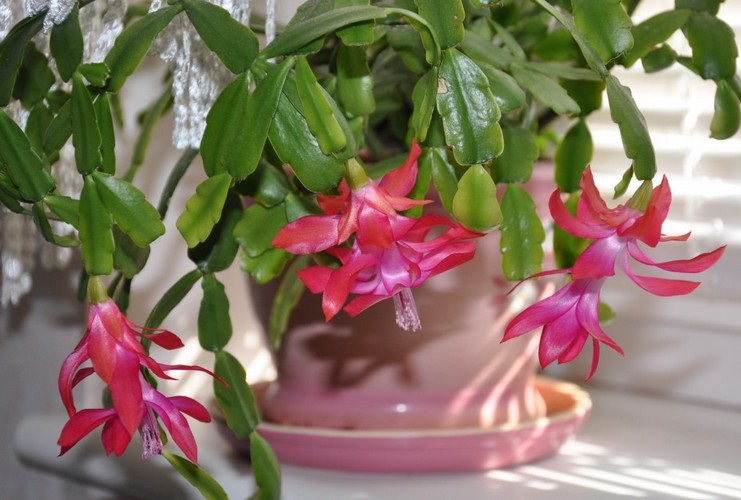
For this reason, the Decembrist tried not to keep it in the house - no one wanted to know in advance about death, especially about his own. Even in the old days there was a sign that a dead flower - a Decembrist - takes a living person with it to another world. Although at the same time, many denied such superstition, believing that if there are no sick people in the house, the omen will not come true.
In fact, modern magicians are inclined to believe that the Decembrist can warn of sudden death in the house and a funeral, but he himself has nothing to do with it. But there are several other signs that can speak of what the Decembrist points to in the house.
Decembrist white varieties
There are many varieties of this plant, but if you want to grow a snow-white zygocactus, then choose the following varieties:
- White Christmas. This variety grows up to 40 cm in height. Differs in large buds with a bright pink stamen.
- Bridgeport. One of the most beautiful white Decembrists. It has large oval buds with fairly wide petals, while the shrub itself is compact and reaches up to 30 cm in height.
- Angel Dance. An unusual variety, in which not only petals are painted in snow-white tones, but also a pistil with a stamen.
- White Bell. Compact variety with two-tiered peduncles.
- Aspen. A distinctive feature of this variety is a terry border at the tips of the petals. The buds themselves can be either completely snow-white or with a slight pinkish tint.
- Madame Butterfly. A hybrid variety with large peduncles and stem segments. It blooms a month earlier than the usual varieties of zygocactus.
- Malissa. Variety with short stems and voluminous, luxurious buds. With proper care, it will delight with flowers for 3-4 months.
Each of these varieties of white Decembrist will decorate your collection of houseplants. But for this you will have to make some effort, and create comfortable conditions for the zygocactus.

Is it possible to achieve this shade at home?
In laboratory conditions of ideal humidity, light and temperature, breeders have many options for crossing. From completely dissimilar species, they can receive new ones.
However, at home, you can try to cross different varieties of the Decembrist. It is a fairly hardy plant and will work as a sample.
- First of all, if we need to get a light-colored zygocactus, then the original varieties should also be taken with white flowers, or at least a light shade.
- Make sure the parent plants are completely healthy. We choose one of them as a pollinator, and the other as a seed plant.
- On the seed bush, we select a good, unblown bud. When it starts to open, it is necessary to cut off all its stamens and close it with a linen bag to prevent contact with pollen from other flowers. A plastic bag will not work, it will not allow air to pass through and the plant may rot.
- When the bud opens wide enough, use a brush or cotton swab to apply pollen from the pollinator to it. You can and just easily shake the pollinator flower over the flower of the seed plant.
- Again we put a linen bag on the experimental bud. The procedure must be repeated every few days. We plant the resulting seeds and wait for young plants.
Snow-white, gorgeous flowers of the Decembrist will decorate any house, any window sill.The duration of abundant flowering, the absence of difficult efforts when leaving, is little susceptible to disease - all this attracts new and new fans to it. Indeed, the beauty and simplicity of caring for a zygocactus is the key to success for both an amateur plant breeder and a professional.
General care rules
The lush and vibrant flowering of Schlumbergera is easy to maintain with very simple maintenance. To do this, it is necessary to bring the conditions of its existence as close as possible to natural ones, taking into account the life cycle of the zygocactus.
In October - November, the plant rests. It should be watered no more than once a week, and the room temperature should be reduced to 18 degrees.
November and December are the time for the buds to appear. Need to follow the condition of the soil and water abundantly as it dries. At the beginning of December, it is necessary to create a humid "fog" around the plant more often and maintain the temperature at least 25 degrees.
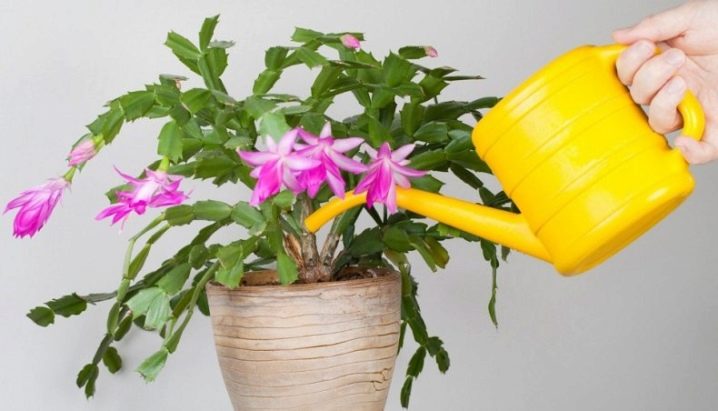
From December to February is the flowering period. The plant loves light, but direct sunlight should not fall on it. At this time, it must be located on the southern, south-western side, to provide high humidity and diffused lighting. You cannot change the location of the pot at this time - the plant can shed its buds.
From March to August, the plant grows actively. At this time, you can transfer to Schlumberger to the north or east side, water well, feed regularly (once every two weeks).

The beautiful formation of the plant, stimulation of flowering is facilitated by a special procedure - plucking the stems. You cannot cut the segments with a knife, they need to be broken off, but it is better to carefully unscrew them. The operation is carried out in early summer, damaged, extra shoots are exposed to it. Thus, by the time of flowering, larger and brighter buds are formed on healthy young stems.
The watering regime should be carefully observed. Although the Decembrist belongs to cacti and is able to accumulate moisture, frequent drying out of the soil harms the plant. But he does not need too much watering either.
It is necessary to water the Schlumberger with warm, clean water (it can be settled, boiled, at room temperature). Cold water cannot be used for this purpose: the roots can rot, and the buds can stop development.
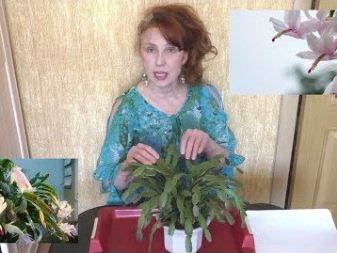

When choosing a soil, it should be remembered that in nature epiphytes grow on trees, so a light and loose mixture of peat, sand, leaf humus and garden soil will be ideal for them. Two thirds of the volume should be occupied by soil, one third by drainage.
The pot for the Decembrist should be wide and low, with several drainage holes.
The Christmas tree needs feeding, like all other plants. Fit fertilizer for cacti or succulents, but the dosage indicated in the instructions must be reduced. The optimal regime is once a month, during the growth period - once every 14 days, in October - early November, the plant should not be fertilized.
It also happens that, despite all the efforts, the Decembrist stubbornly does not want to bloom. To "wake up" the plant, experts advise to move it in mid-September to a cool place and leave it alone for one or two months. By the end of November, expose to diffused sunlight and increase watering.


When growing a Schlumberger, it must be remembered that the flower is really unpretentious and tenacious. It is a wonderful neighbor for other houseplants.
But abundant flowering, bright color of the petals can only provide correct and timely care. The plant will die only in the most extreme case, but it is quite capable of stopping flowering.


For even more about the types and varieties of the Decembrist, see the next video.
Description
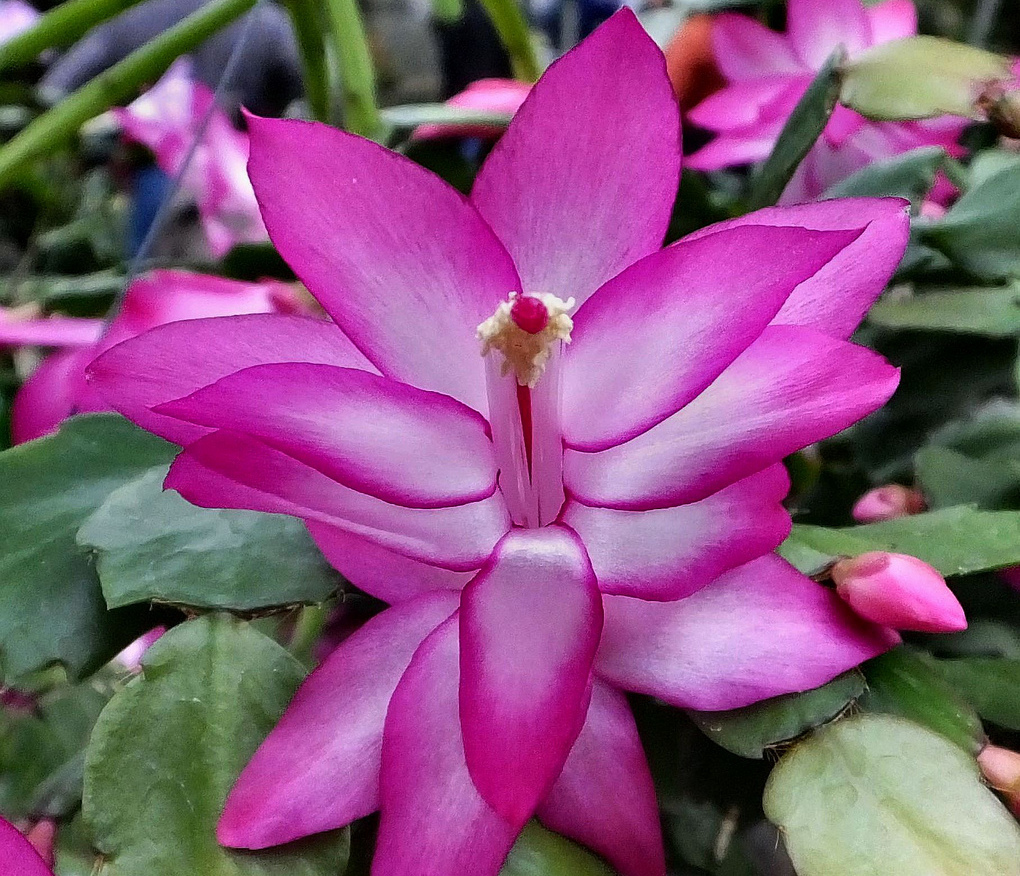
The Decembrist belongs to a large family of forest cacti. In its natural environment, this epiphyte can be found in the tropical rainforests of South America, where does he grow on the branches and roots of trees.Zygocactus was introduced to European countries at the beginning of the 19th century, and it instantly won the love of flower growers, thanks to its non-capricious character and high decorativeness.
Schlumberger's zygocactus is an evergreen shrub reaching 30-50 cm in height. He has a voluminous crown, consisting of hanging stems. Shoots are formed from segments that resemble dense leaves.
The culture blooms in winter, for which, in fact, it got its name. Cactus buds form on the tops of the stems. Peduncles are tubular, multi-tiered, with long stamens. The petals are colored red, white, yellow, purple and pink.
Thanks to the work of breeders, many varieties of flowers have been obtained. The following varieties are especially popular:
- Decembrist Russeliana. The variety is fast growing. Its shoots reach up to 80 cm in height. The leaves are flat, corrugated along the edges, painted in a dark green color. The petals of large peduncles are slightly pointed at the tips.
- Decembrist Gertner. Large shrub, covered with dense, fleshy leaves. Bell-shaped peduncles are painted in rich bright orange colors.
- Decembrist Boukley. The plant reaches up to half a meter in height. The buds are large, multi-tiered up to 8 cm long. The variety is distinguished by long flowering, which begins in November and ends in March.
If you create comfortable conditions, then loving these varieties of zygocactus will become an adornment of the collection. This is confirmed by the following photo of the Decembrist flower.

Possible growing problems
When leaving in compliance with all the rules, the zygocactus grows well and blooms profusely. However, problems during cultivation can arise, so it is recommended to study the main ones.
Diseases and pests of the Decembrist
The plant can be precipitated by some insects and fungal diseases. Therefore, the leaves of the plant should be periodically inspected.
- If whitish lumps, like cotton wool, appear between the shoots, it means that the Decembrist is infected with a mealybug. Getting rid of a pest is quite difficult. We need urgent treatment of the plant with special preparations that are sold in flower shops.
- The leaves covered with a rusty bloom and an almost invisible cobweb indicate that the zygocactus is infected with a spider mite. They are very small and almost invisible insects of reddish, yellow or brown color. They appear when there is insufficient air humidity. You can get rid of them with the help of the drug "Neoron", "Fitoverm", "Actellik".
- Of the fungal diseases, the Decembrist is most often affected by phytophthora, phytum, fusiriosis. First of all, the root collar of the flower suffers, as a result of which it begins to wither in moist soil, becomes gray and pale, and loses its segments. In this case, the plant must be treated with Vitaros, Topaz and Maxim fungicides. In addition, you need to ensure that the soil does not become waterlogged. It should dry well between waterings.
Why doesn't the Decembrist bloom?
Most often, the reason lies in non-compliance with the growing conditions:
- Insufficient watering.
- Insufficient lighting.
- The pot is too small for the plant and a transplant is required.
- Insufficiently nutritious soil.
In order for the plant to bloom, it must be properly prepared for flowering. For this, in the fall, he is provided with a dormant period, removing the zygocactus in a cool room. At this time, it practically does not need to be watered and does not need to be fed at all. To make the zygocactus bloom, at the end of November it is moved to a well-lit place and watered. The plant will "wake up" and begin to pick up buds.
To achieve abundant flowering of the Decembrist, it is necessary to properly care for it:
In winter, it is recommended to illuminate the plant with an additional source of illumination.
During the flowering period, you cannot move and rotate the pot, as well as prepare cuttings for propagation.
It is strictly forbidden to expose the plant to temperature extremes during flowering.
If there is cool air in the room, the flowering will last longer.
The bush will bloom profusely in a narrow pot.
A more active flowering is facilitated by a temperature regime not higher than + 16C.
After a dormant period, watering and feeding is resumed very carefully. Otherwise, the plant can get a lot of stress and shed its buds .. If you brought a blooming Decembrist home, and its flowers began to fall off, you should not panic
The plant simply adapts to new growing conditions
If you brought a blooming Decembrist home, and its flowers began to fall off, you should not panic. The plant simply adapts to new growing conditions.
Why does zygocactus wither?
As mentioned above, the plant withers if it suffers from fungal diseases. But there may be another reason - this is rotting of the roots.
If the trunk of the Decembrist began to sway, and the flower itself lost its stability, then it is possible that its roots have died. This can happen as a result of watering with cold water, hypothermia of the plant, or, conversely, from overheating of the flowerpot in the sun. Too much fertilizer can burn the roots.
If such a problem is found, the flower needs to be urgently transplanted into another soil. When transplanting, the roots are examined, the affected ones are removed. Then the root system of the plant is sprinkled with a little crushed coal and dried. After that, the zygocactus is planted in a fresh earthen mixture and watered only as needed.
Why do leaves fall?
Decembrist leaves can fall off, seemingly, for no reason. However, nothing happens so easy, so you should find out the reason:
- If the plant is infected with pests, then it is treated with special preparations.
- If the leaves of the plant are clean, and there are no insects on them, then perhaps the reason is a lack of nutrients. In this case, the Decembrist is watered or sprayed with fertilizers for epiphytic cacti.
- The reasons for the falling off of the end segments can be: a draft, sudden temperature changes, too dry air, or a transplant made at the wrong time.
Potential problems, diseases and pests
Most often, the Decembrist suffers from fungal pathologies. The three most common are fusarium, phytium and late blight. In principle, for such diseases, fungicidal preparations are used, but in each case there are some nuances. For example, with phytophthora and phytium, root necks are affected, they are primarily treated with special preparations. There are also cases of bacterial infection, with a dark spot appearing at the bottom of the stem, and then quickly spreading over its entire surface. Sometimes the stem is discolored or reddish.
Withering of the Decembrist
Antibacterial drugs, paradoxically, do not work with such diseases. Most often, you just have to remove the damaged part of the plant. If too large an area of the stem is affected, then cuttings are carried out. Then there are chances of getting some healthy Christmas trees. But you will have to say goodbye to the old plant. And, by the way, the contaminated soil must also be thrown out mercilessly.
If we talk about pests, then for the Decembrist the biggest problem can be spider mites (you can get rid of them with insecticidal preparations such as "Fitoverm") and mealybugs that resemble white lumps - special substances are also released against them.
Why does the Decembrist not bloom? This is one of the most common questions on florist forums. The reason usually lies in the wrong organization of lighting and poorly selected ground. The Christmas tree will not grow well on the north window. But he does not like direct sunlight, so sometimes he needs additional shading. If the flower begins to wilt, then this may be the result of insufficient air humidification.In winter, this is most often due to central heating radiators. Therefore, if the air in the room is dry, then you need to make the spraying of the plant more intense, but within reason. Finally, a wilting plant is a reason to think about changing the soil in the pot to a more nutritious one.
Why does zygocactus fall off? If the Decembrist's leaves are crumbling, this means that it is watered too abundantly. Like any cacti, the Decembrist tolerates dry soil better than wet soil. In such cases, take a break in watering for several days, then pull the plant out of the pot, and together with an earthen lump, and check the roots. If they have already begun to rot or a characteristic musty smell is felt, then you need to plant healthy cuttings of the plant in other pots, since this specimen cannot be saved anyway. You can change the soil to clear your conscience and transplant a Christmas tree there, but this rarely gives the desired result.


